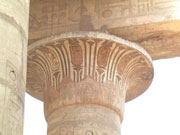TOUR NEWS - TURKEY SEPTEMBER-OCTOBER 2006
The B.C. Archaeology Tour of Turkey in September-October 2006 was a great success with everyone enjoying the splendid sites of this beautiful country. The tour group consisted of 12 enthusiastic participants who were all eager to survey the ruins in this 19 day program exploring the antiquities of Turkey. This included: Robin and Robert Callister, Cathy Clarke, Jane and Mike Costello, John and Lyn Dun, Robyn and Bill Hawkshaw, Margaret Larkin, Bob Snow, and Alan Stuckey. The group was lead by Dr Michael Birrell and the Turkish guide was Sedat Cakmak who added much interesting information about local culture and modern history.
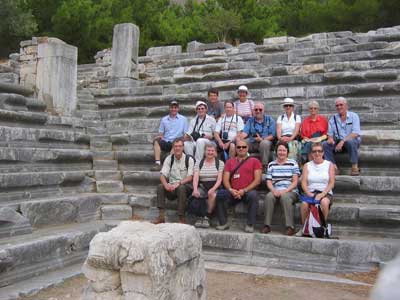 |
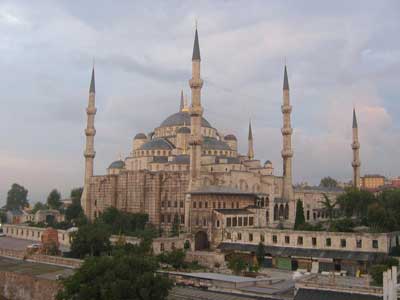 |
The Sept-Oct Tour of Turkey |
The Blue Mosque in Istanbul |
The tour began in Istanbul where we stayed for a few days in the comfortable Askin Hotel. This is located in the historic heart of the city, a short walk from the Blue Mosque. This family run hotel is in the picturesque suburb of Sultanahmet and from the roof, where we had our breakfasts, there was a magnificent view of the Bosphorus and the Blue Mosque. Our first afternoon took us through the area of the Hippodrome with its fascinating collection of antiquities including an obelisk of the Egyptian pharaoh Tuthmosis III. From here we walked to the Grand Bazaar with its colourful markets.
The following two days were spent exploring some of the historic sites of Istanbul. We saw the marvellous Archaeological Museum with its rich collection of classical sculpture and artefacts from Troy. We also saw the nearby 'Basilica Cistern' built by the Byzantine Emperor Justinian to contain an enormous volume of water for the city. It is an awe inspiring underground complex! We also spent a day wandering around the mediaeval Ottoman Palace known a Topkapi. The palace is justly famous for its superb harem rooms lined with sumptuous Iznik tiles, and the exhibited treasures of the Ottoman Sultans. We explored this vast complex of courts, gardens, and state rooms, and had lunch near famous Seraglio Point overlooking the Bosphorus.
We then travelled southward by coach along the shore of the Sea of Marmara to the Gallipoli Peninsula. We stopped for lunch near the Dardanelles Strait and then toured the main battle sites including Anzac Cove, Lone Pine and the Nek. The view from the summit gave us a chance to appreciate the incredible hardships faced by fighters on both sides. In the afternoon we crossed the Dardanelles by ferry and checked into our hotel in Canakkale.
The following day we spent 4 pleasant hours at the site of Troy, a fascinating archaeological spot famously excavated in the late 19th Century by Heinrich Schliemann. We took our time to really examine the site in detail and also read through some atmospheric quotes of Homer dramatic poem 'The Iliad'. In the afternoon we returned to Canakkale to explore the town and the local fort containing a collection of WWI artefacts.
The following day we headed south to the town of Bergama. The bus trip took us through dramatic mountainous country and along the scenic coast. We had some lunch in the town before visiting the Red Hall, the ancient Temple of Serapis, and the town's Archaeological Museum with an interesting collection of artefacts from the local excavations. The next day was devoted to the beautiful ruins of the ancient city of Pergamon perched on the top of a nearby hill. This Hellenistic city developed as a major centre of art and culture in the 3rd and 2nd Century BC, and we took our time to explore the royal palaces, the library, the remarkable theatre and the Temple of Trajan. Unlike most tourists we then walked down through the middle city to explore the Temple of Demeter and the picturesque Gymnasium complex - John, always interested in wandering off to take photographs, managed to loose himself in the ruins but caught a taxi and met up with us later! In the afternoon, after a late lunch, we explored the Asklepeieon, the ancient medical centre with its fascinating complex of buildings.
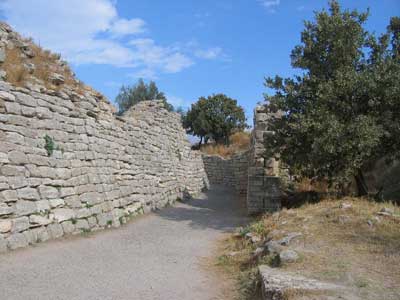 |
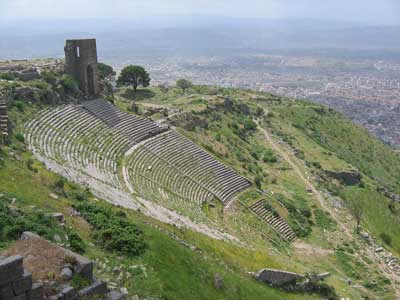 |
The walls of Troy |
The theatre on the acropolis at Pergamon |
We next spent a morning at a local carpet factory learning how silk is produced and how carpets are woven - many members of the group bought more carpets than expected! Our travels then took us south to Selcuk where we stayed in the small family run Bella Hotel which has picturesque views over Selcuk's ancient Turkish fort. This was to be our base for the next 6 days as we toured the sites in the local area.
We spent a day exploring the wonderful ruins of Ephesus, one of the most heavily visited sites in the Mediterranean - thankfully these 'tourists' only stay about 1 hour and head back to their cruise ships, giving the rest of us 'students of history' the opportunity to have a more in-depth look at the city over 5 hours. This included the newly revamped display of the wealthy private houses now accessible via an impressive perspex staircase that enables you to walk through the houses and see the mosaics and frescoes in detail. The next day we saw the superb ruins of Priene, an ancient city perched on a dramatic hillside with picturesque ruins of the agora, town hall, theatre, and awe inspiring Temple of Athena. The afternoon was spent in the Selcuk Archaeological Museum with its fascinating collection of artefacts from Ephesus and the local area.
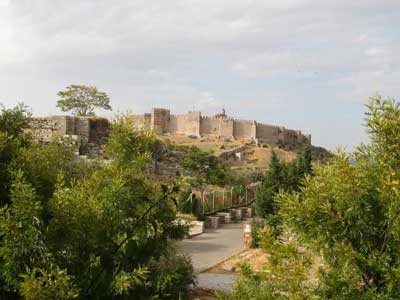 |
 |
The fort at Selcuk |
The famed library of Celsus at Ephsus |
A day was then spent at the ruins of Miletus and the nearby dramatic ruins of the Temple of Apollo at Didyma. We had some fun trying to locate the ancient lions which guarded the entrance to the harbour of Miletus, now half buried in silt. A free day then provided a much needed rest, although most of us could not resist the urge to shop at the local markets. In the afternoon we went up into the hills for a wander around the very pretty little village of Sirince. Dating to the 19th Century it is preserved as a heritage enclave. A very pleasant evening meal was had on the terrace with a panoramic view of the village and surrounding countryside.
 |
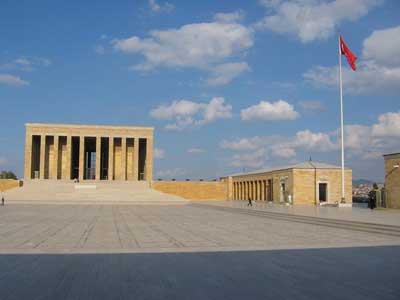 |
Dinner in the historic village of Sirince |
The Mausoleum of Ataturk in Ankara |
A day trip to the site of Aphrodisias, sacred to the goddess of love, enabled us to explore this wonderful site famous for its well preserved stadium and beautiful sculpture. Mike and Jane enjoyed relaxing in the hammocks at the restaurant. We next flew to Ankara where we spent an afternoon at the Ataturk Mausoleum, a dramatic modern building with interesting War Memorial collection. The following day we travelled east of Ankara to the ancient Hittite capital of Hattusas, set in a dramatic mountain landscape and preserving impressive remains of temples, palaces, and city gates from 3500 years ago. A pleasant lunch was had at a local hotel before we explored the rock-cut shrine of Yazilikaya with its representation of the chief Hittite gods. Our last day in Ankara enabled us to explore the scenic citadel, have an ice cream and spend time in the Museum of Anatolian Civilisations.
The last few days of our tour were spent in Cappadocia, famed for its impressive landscape of weathered volcanic ash in the foothills of the Erciyes volcano. We travelled south by bus from Ankara via an enormous salt lake and checked into our comfortable hotel in Urgup. This was our base for exploring Uchisar Castle, a dramatic outcropping of pumice, the picturesque ruins of Goreme and the striking landscape of Zelve. Many members of the group took the opportunity of a dawn balloon ride above this magical landscape.
 |
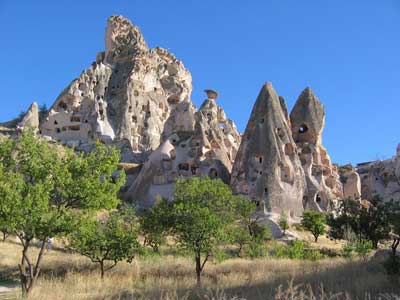 |
The city gate of Hattusas |
The Fairy Chimneys of Cappadocia |
We subsequently flew back to Istanbul where we toured the remarkable Haghia Sophia basilica, built in the 6th Century AD by the Byzantine Emperor Justinian. We also saw the impressive Blue Mosque built in the 17th Century at the height of the Ottoman Empire. Last minute shopping in the Grand Bazaar saw the end of our wonderful adventures in Turkey before the flight back to Australia.
Michael Birrell
